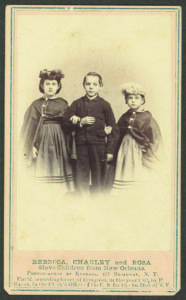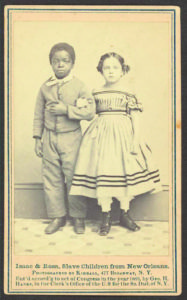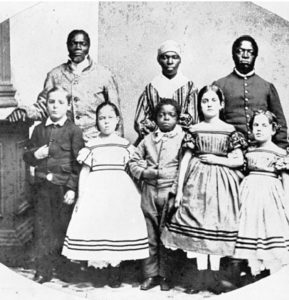
 In one of my favorite Agatha Christie Hercule Poirot TV productions, “The Adventure of the Clapham Cook,” the little Irish housemaid “Annie” speculates to Poirot that the missing cook has been carried away by “White Slavers.” This is an amusing little scene, intended, no doubt, to inject a bit of humor into the mystery. However, to poor little Annie, this might, indeed, have been a very real peril.
In one of my favorite Agatha Christie Hercule Poirot TV productions, “The Adventure of the Clapham Cook,” the little Irish housemaid “Annie” speculates to Poirot that the missing cook has been carried away by “White Slavers.” This is an amusing little scene, intended, no doubt, to inject a bit of humor into the mystery. However, to poor little Annie, this might, indeed, have been a very real peril.
A Belgian, Poirot would have likely known little of Irish history, written and oral. Had he been aware of it, his amusement produced by the Irish housemaid’s speculation that the missing cook was taken by “white slavers” would have made Annie’s anxiety somewhat credible.
 King James VI and his successor Charles I led a continued effort to enslave the Irish. Britain’s Oliver Cromwell furthered this practice of dehumanizing one’s next door neighbor.
King James VI and his successor Charles I led a continued effort to enslave the Irish. Britain’s Oliver Cromwell furthered this practice of dehumanizing one’s next door neighbor.
The Irish slave trade began when James VI sold 30,000 Irish prisoners as slaves to the New World. His Proclamation of 1625 required Irish political prisoners be sent overseas and sold to English settlers in the West Indies.The Calendar of State Papers, Colonial Series of 1701 records 25,000 slaves in Barbados in which 21,700 were white slaves.
 George Downing wrote a letter to the honorable John Winthrop Colonial Governor of Massachusetts in 1645, “planters who want to make a fortune in the West Indies must procure white slave labor out of England if they wanted to succeed.” Lewis Cecil Gray’s History of Agriculture in the Southern United States to 1860 vol.1 records Sir George Sandys’ 1618 plan for Virginia, referring to bound whites assigned to the treasurer’s office. “To belong to said office forever. The service of whites bound to Berkeley Hundred was deemed perpetual.”
George Downing wrote a letter to the honorable John Winthrop Colonial Governor of Massachusetts in 1645, “planters who want to make a fortune in the West Indies must procure white slave labor out of England if they wanted to succeed.” Lewis Cecil Gray’s History of Agriculture in the Southern United States to 1860 vol.1 records Sir George Sandys’ 1618 plan for Virginia, referring to bound whites assigned to the treasurer’s office. “To belong to said office forever. The service of whites bound to Berkeley Hundred was deemed perpetual.”
By the mid-1600s, the Irish were the main slaves sold to Antigua and Montserrat. At that time, 70% of the total population of Montserrat were Irish slaves.
Ireland quickly became the biggest source of human livestock for English merchants. The majority of the early slaves to the New World were actually white.
Author John Martin’s essay, “The Irish Slave Trade — The Forgotten White Slaves,” is about the 100,000 Irish people sent as slave labor to the new British colonies in the 1650s to 1660s. It began in 1625 when James II issued a proclamation that 30,000 Irish political prisoners be sent to the Caribbean. It escalated 25 years later under Oliver Cromwell, Lord Protector of England, Wales, Scotland and Ireland. By his death in 1658 the Irish population of 1.5 million was down to an estimated 600,000.
Families were ripped apart as the British did not allow Irish dads to take their wives and children with them across the Atlantic. This led to a helpless population of homeless women and children. Britain’s solution was to auction them off as well.
During the 1650s, over 100,000 Irish children between the ages of 10 and 14 were taken from their parents and sold as slaves in the West Indies, Virginia, and New England. In this decade, 52,000 Irish (mostly women and children) were sold to Barbados and Virginia.
Another 30,000 Irish men and women were also transported and sold to the highest bidder. In 1656, Cromwell ordered that 2,000 Irish children be taken to Jamaica and sold as slaves to English settlers.
From the 17th to the 19th centuries, tens of thousands of British and Irish indentured servants immigrated to British America. The majority of these entered into indentured servitude in the Americas for a set number of years willingly in order to pay their way across the Atlantic, but at least 10,000 were transported as punishment for rebellion or other crimes, then subjected to forced labor for a given period.
African slaves were very expensive during the late 1600s (£50 Sterling). Irish slaves were cheaper (no more than £5 Sterling).
Until the late 18th century, indentured servitude was very common in British North America. It was often a way for poor Europeans to immigrate to the American colonies: they signed an indenture in return for a passage. After their indenture expired, the immigrants were free to work for themselves or another employer. In some cases, the indenture was made with a ship’s master, who subsequently sold the indenture to an employer in the colonies. Most indentured servants worked as farm laborers or domestic servants.
Between one-half and two-thirds of white immigrants to the American colonies between the 1630s and American Revolution had come under indentures.
Many documents verify the bondage, kidnapping, and transporting of English, Irish, and Scots to the Colonies as slaves. This article may help to provide an explanation to those who cannot find a ship passenger list on an ancestor.
Sources: AmericasFreedomFighters.com; Wikipedia.com; www.douglashistory.co.uk/slavery/whiteslavetrade
No Comments
Leave a comment Cancel